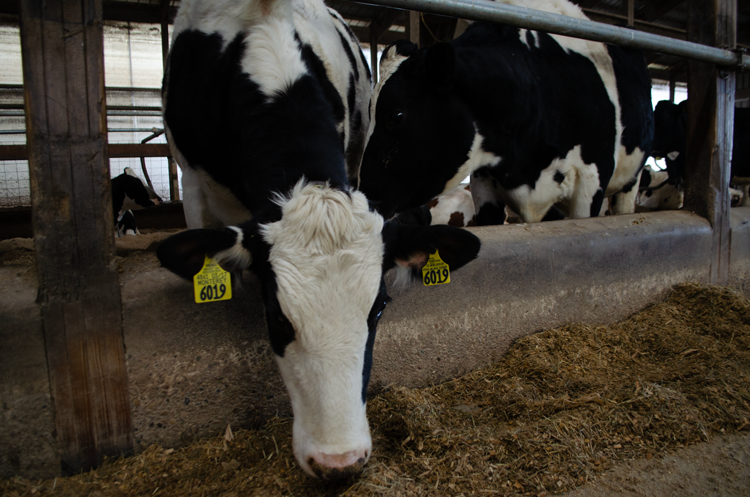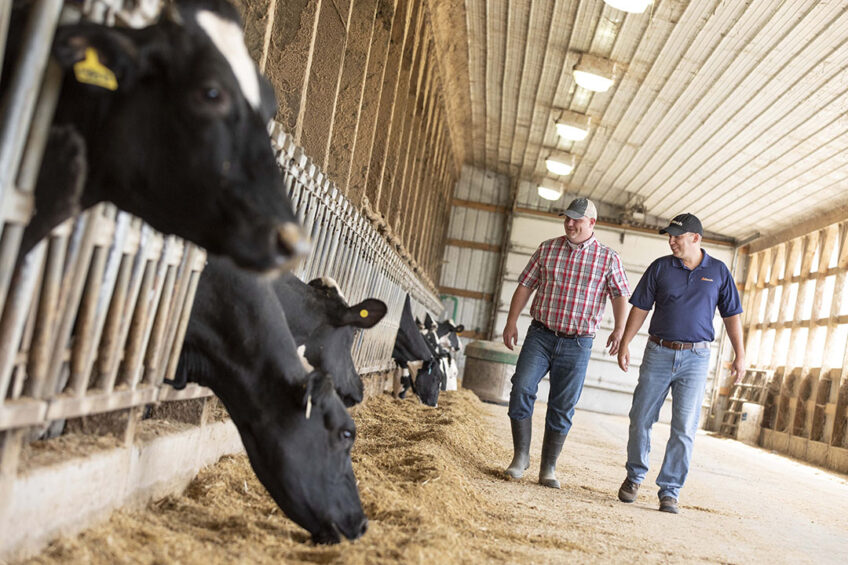Boost your dairy herd’s health with choline. Discover how this essential nutrient can improve transition cows’ liver function and overall performance. Ready to learn more?

Dairy producers who want to maintain high output and healthy herds from their cows depend on their condition throughout the transition. Three weeks before and three weeks after calving, this crucial period involves notable metabolic changes that provide difficulties. One main problem is hepatic lipidosis. Too much fat accumulates in the liver and influences almost half of dairy cows in early lactation. This condition is associated with many illnesses and reduced output; hence, it is essential to address for sustainable farming and improved herd health.
“Managing the transition period well can mean the difference between a thriving dairy operation and one suffering health and production problems,” said one experienced dairy farmer.
Including choline, particularly rumen-protected choline (RPC), in the cow’s diet shows promise. Choline helps eliminate fat from the liver, hence lowering hepatic lipidosis. Including RPC in transition meals helps farmers improve the general performance and lifetime of their cows and their liver condition.
- Less hepatic fat buildup
- Better fat digestion
- Improved performance beyond the transition period
Combatting Fatty Liver Disease: A Crucial Focus for Dairy Farmers
Hepatic lipidosis—fatty liver disease—is common in dairy cows during the transition period around calving. This disorder significantly compromises dairy cows’ health and output.
Cow metabolic alterations in late gestation and early lactation help to enhance milk production. If lipids overload the liver moved from bodily reserves, these alterations might cause fat storage there. Hepatic lipidosis follows from this buildup of triacylglycerol in the liver cells.
Higher rates of conditions like ketosis, displaced abomasum, and metritis are associated with hepatic lipidosis. These diseases lower the cow’s general condition and milk output, influencing farm profitability. Other metabolic problems may also result from compromised liver performance brought on by severe lipidosis.
Knowledge of and control of hepatic lipidosis is vital for dairy producers. Good plans include dietary supplements containing rumen-protected choline to aid with this issue.
Choline: The Unsung Hero in Dairy Cow Nutrition
Dairy cows need choline, particularly in the transition phase when their physiological needs are excellent. Choline is a lipotropic molecule essential for liver metabolism, helping to export lipids. This lowers the likelihood of hepatic lipidosis, which may compromise cow performance and general condition. Adding rumen-protected choline (RPC) guarantees sufficient choline levels, aiding fat control and improving lipid metabolism from the diet.
Understanding the Myriad Benefits of Supplementing Dairy Cow Diets with Rumen-Protected Choline (RPC) Lays the Foundation for Improved Herd Management, Specifically During the Critical Transition Period
Knowing the many advantages of adding rumen-protected choline (RPC) to dairy cow diets sets the stage for better herd management—more so during the crucial transition phase. When feed limits arise, dairy cows might develop dangerously high triacylglycerol levels in their liver tissue. This compromises their output and general health. RPC is a powerful agent that lowers this risk by lowering triacylglycerol intrusion into hepatic tissue and enabling the export of these lipids as nascent lipoproteins.
Moreover, RPC in dairy cow diets increases the production of chylomicrons necessary for lipid transfer within enterocytes, thereby improving fat digestibility. This improvement aids cows in better absorbing and using dietary lipids, therefore improving general energy balance and milk output. Improved fat digestion and increased lipid export show RPC’s vital function throughout the transition phase, which results in more excellent health and long-lasting performance enhancements.
The Intricate, Multi-Faceted Benefits of Rumen-Protected Choline on Liver Health
One of the most fascinating features of supplementing choline, particularly rumen-protected choline (RPC), is its effect on secondary liver pathways.
Choline stimulates lipophagy and cellular autophagy, mechanisms whereby injured cells break down lipid droplets and precise away broken components. This helps eliminate extra lipids, therefore preventing hepatic lipidosis.
Choline also reduces stress related to the endoplasmic reticulum (ER). The ER handles protein folding and lipid synthesis; stress causes inflammation and compromised liver function. Choline helps phosphatidylcholine production, stabilizing ER membranes and enhancing good cell function.
This lowers hepatocyte inflammation, a significant component impeding liver function during the postpartum transition phase. Choline’s anti-inflammatory action supports a better liver environment.
Together, these systems help lower the degree of hepatic lipidosis. Lower ER stress and inflammation benefit general liver function, while enhanced autophagy and lipophagy help digest lipids. Along with treating fatty liver disease, this all-encompassing strategy increases dairy cows’ long-term health and output. Dairy producers may make more wise judgments on herd management by using these interactions, particularly during the crucial transition time.
Rumen-Protected Choline: A Game-Changer for Long-Term Productivity in Dairy Farming
One of the main benefits of adding rumen-protected choline (RPC) to dairy cow diets is the notable increase in productive performance. This development not only lasts temporarily but also lasts well into the lactation cycles, therefore boosting output. These advantages show the global influence of RPC as they are constant among cows of various body states. RPC encourages a better metabolic state by improving lipid metabolism and lowering hepatic lipidosis, generating continuous milk supply and better general herd health. Find out more about keeping a solid dairy herd.
Maximizing the Benefits of Rumen-Protected Choline: Precision Guidelines for Dairy Farmers During the Transition Period
Following these fundamental rules will help you maximize Rumen-Protected Choline (RPC) in your dairy cow diets:
Start RPC at least three weeks before calving and keep it going for at least three weeks after. This supports cows throughout the vital metabolic change.
Generally speaking, 12 to 25 grams daily is the recommended dosage. See a nutritionist for the correct herd dose.
In diets, it is advised to include RPC equally into the total mixed ratio (TMR). Verify that the product is indeed rumen-protected to maximize choline absorption.
Watch cows’ health, physical condition, and milk output for changes. Based on professional advice and consistent evaluations, change the dose.
These guidelines may safeguard liver health, increase fat digestion, and raise general output.
The Bottom Line
Choline is crucial for dairy cow health, especially in the transition phase. It helps export liver lipids, lowering the danger of peripartum illnesses and improving productive function. Thus, it helps fight hepatic lipidosis. Rumen-protected choline (RPC) enhances fat digestion and boosts hepatic metabolism, promoting healthier cows and increasing milk output. Including RPC is a deliberate decision dairy producers make to improve herd health and production.
Key Takeaways:
- Approximately 40% to 50% of dairy cows develop hepatic lipidosis in the early stages of lactation, leading to elevated risks of peripartum diseases and compromised productivity.
- Choline, especially when supplemented as RPC, assists in the export of lipids from the liver, thus mitigating the effects of hepatic lipidosis.
- Supplementing with RPC not only reduces triacylglycerol accumulation in the liver but also improves fat digestibility by facilitating lipid transport within the enterocyte.
- RPC supplementation enhances cows’ productive performance during the critical transition period, with benefits extending well beyond the actual supplementation phase.
- Understanding the secondary pathways affected by choline, such as autophagy and lipophagy, can provide further insights into reducing hepatic lipidosis severity.
Summary:
Dairy producers must manage the transition period between calving and lactation to maintain high output and healthy herds. This period involves significant metabolic changes, including hepatic lipidosis, which is associated with many illnesses and reduced output. To address this issue, dairy producers should focus on managing the transition period well by including choline, particularly rumen-protected choline (RPC), in the cow’s diet. Choline helps eliminate fat from the liver, lowering hepatic lipidosis, and improving the general performance and lifetime of their cows and their liver condition. RPC lowers the risk of hepatic lipidosis by lowering triacylglycerol intrusion into hepatic tissue and enabling the export of lipids as nascent lipoproteins. It also increases the production of chylomicrons necessary for lipid transfer within enterocytes, improving fat digestibility and enhancing general energy balance and milk output. To maximize the benefits of RPC in dairy cow diets, dairy producers should start RPC at least three weeks before calving and keep it going for at least three weeks after.












